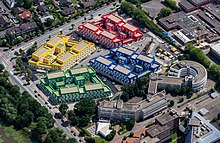Münster-Aaseestadt

The Aaseestadt is a district in the core area of the city of Münster in Westphalia . It belongs to the Mitte district . The Aaseestadt is located east of the Aasee and south of the Kolde-Ring . In the east it is bounded by the federal highway B219 (Weseler Straße) and in the south by the Boeselagerstraße , approximately at the transition from the B219 to the A43 motorway . The proximity to the Aasee and the comparatively high number of green areas and parks make the Aaseestadt a popular residential area. Around 5500 people live in the almost 1.5 km² district.
The Aase city includes the Catholic St. Stephen's Church and the Evangelical St. James Church . The Dietrich-Bonhoeffer-Schule is the urban primary school of the district, adjoining is the sports complex with the club SV Blau-Weiß Aasee and the police training institute Carl Severing (formerly: Higher State Police School ). There is no secondary school in the Aaseestadt, but the Episcopal Peace School is directly adjacent in the Mecklenbeck district and thus helps shape this district.
The Aaseemarkt , the district's shopping center , is particularly notable for its unusual design: it is a kind of platform that can be accessed via stairs and ramps. In the Aaseemarkt there are various, sometimes changing shops, such as a pharmacy, pizzeria, drugstore, TV shop, driving school and supermarket, but also some rental and owner-occupied apartments .
The three yellow skyscrapers, which were built by Karl-Friedrich Sommer in 1959 and which are unusual for the Aase city, which is otherwise dominated by single and multi-family houses, are visible from afar. However, the LVM Versicherung office tower erected in 1999 towers above them. All buildings are located directly on Kolde-Ring , i.e. the side of the Aase city facing the city center.
Individual evidence
- ↑ a b Ursula Richard-Wiegandt (author), City of Münster, City Planning Office (ed.): Münster and its districts - 30 years of incorporation 1975-2005. Urban development from the early beginnings to 2010. Aschendorff Verlag GmbH & Co. KG, Münster 2005, ISBN 3-402-00393-7 , p. 36 f.
- ^ Sylvaine Hänsel, Stefan Rethfeld: Architecture Guide Münster. Dietrich Reimer Verlag, Berlin 2008, ISBN 978-3-496-01276-4 , p. 209 ff.
Coordinates: 51 ° 57 ' N , 7 ° 36' E
